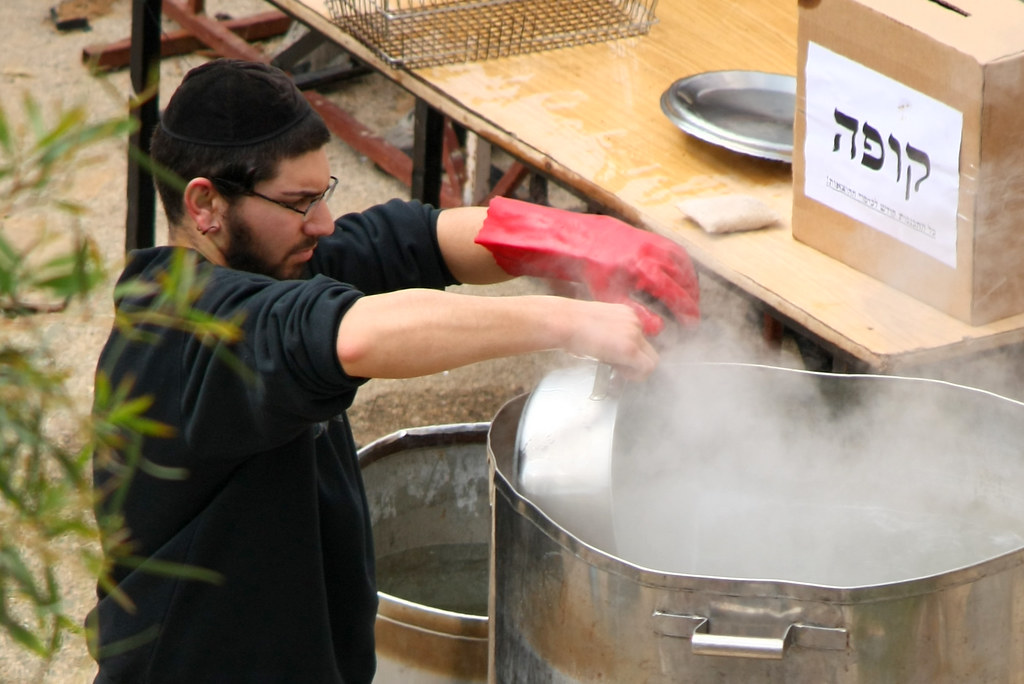The requirement to make dishes Kosher was originally mentioned in the Torah regarding dishes looted from non-Jews at war[1]. It is based on the notion that the flavor of the non-Kosher food was absorbed in the dishes. If they will be used without Koshering, the flavor will be exuded into the food and will make it non-Kosher. There is a simple rule which governs the process of Koshering dishes: כבולעו כך פולטו – It exudes the same way it absorbs.
The meaning of this rule is that if a certain dish is used with boiling liquids, the flavor should be extracted from it by using boiling water. If it is used directly on the fire, it has to be heated, empty, to a higher temperature. There is an extensive discussion in the Halakhic literature regarding the fine details of this requirement, but they all depend on the assumption that the dish absorbed flavor from the non-Kosher food. This factor must be examined in order to determine how to make dishes kosher.
There could be several circumstances when koshering would be necessary, for example: for Pesah, in case of a mixture of dairy and meat, when staying at a hotel room or at an Airbnb.
When discussing material quality of dishes in the modern kitchen, we have to take into consideration the tremendous progress achieved in the field since the industrial revolution. Some materials, such as clay, were used in antiquity but are not used today, while others, such as Stainless Steel, Teflon, Bakelite (poly-oxy-benzyl-methyl-englycol-anhydride), plastic, and Pyrex, are new inventions.
The Halakhic literature recognizes two systems for determining koshering method. One is the absorbent/non-absorbent divide, and the other is by material: wood/metal/clay and so on. Since modern materials differ from their namesakes in antiquity, it is understood that when we want to define the status of a certain dish, we should use the general halakhic yardstick of absorption and not the material label for the dish.
Here are a few documented examples of physical changes in the absorption of dishes:
- The Talmud speaks of “sweating dishes”[2] in reference to dishes in which the food travels through the dish and can be seen from the outside – this never happens with modern dishes.
- The Mishna says that liquids are absorbed in the utensils containing them, at a level between 1.5% and 15% of the original volume of the liquid[3]. In today’s utensils the absorption is less than 1:175,000 or 0.00000006%.
- Rabenu Nissim writes[4] than when koshering many dishes one has to change the water frequently because the residue exuded from the dishes could turn the water into thick sauce. This also does not happen today.
There are opinions that measuring the level of absorption in utensils should be conducted with scientific methods, and that even then the results might not be reliable[5]. We know, however, that the Talmud says[6] that in order to check whether flavor was absorbed in a utensil or a dish, one could taste it, in case it is not a forbidden flavor. For example, if Terumah (sacred food which only the kohanim could eat) was cooked with regular food, a kohen would taste the food. If it tasted like the Terumah, it would be given to the kohanim, and if not, regular people could eat it. In case the flavor is forbidden, such as in a mixture of dairy and meat, we ask a non-Jewish chef to taste it.
The famous rule of 1:60 ratio between the ingredients of the mixture is used only if there is no non-Jew available to taste it, or if the two ingredients have the same flavor, for example, kosher and non-kosher fat. The statement of the Talmud that we rely on one’s taste buds is supported by the rulings of great scholars, who say that laws which depend on human senses are defined by these very senses and not by scientific tools. Here are a couple of examples:
Rabbi Ovadia Yosef says[7] that the sharpness of a slaughtering knife is determined by touch, and that the question of whether a Matzah is well baked is determined by our eyesight.
Similarly, Rabbi Yosef Messas writes[8] that looking for bugs in fruits and vegetables should be done with the naked eye and not by magnifying glass or other tools.
Following the guidelines of the Talmud and these great scholars, we can now say that in order to check whether a certain dish or utensil absorbs flavors, we are allowed, or even obligated, to rely on our taste buds. Here is how it is done: Have a person with a healthy sense of flavor conduct the following experiment:
- In a pot, cook a pound of habanero peppers with oil and garlic;
- Empty the pot and rinse it thoroughly with detergent the way you usually wash it;
- In the clean pot, cook a pound or bland rice, with no salt or spices;
- Taste the rice.
If you feel the spicy flavor, it means that the pot absorbed it from the peppers and exuded it into the rice. If not, it means that there is no absorption.
If you do not want to conduct this experiment, it is fine. It has already been done. With the exception of wood and earthenware, the dishes in the modern kitchen do not absorb flavor. This is true regarding all types of metal, plastic, glass, and Pyrex.
As explained above, the modern kitchen uses dishes, utensils, and tableware, which are non-absorbent. To that we have to add that even if some flavor has been absorbed, if the utensil has not been used for 24 hours, that flavor which is considered spoiled and unwanted (נותן טעם לפגם). We also use very powerful detergents and scrubbers, so even if there was an absorbed flavor, it would have been overcome, if not completely removed, by the detergent.
The implication of these facts and rules is that once we know a certain dish is non-absorbent we could use it after it was cleaned in the regular method, without boiling or burning. This is true regarding koshering a dish for Pesah, converting it from meat to dairy and vice versa, and using dishes at a hotel.
The idea of converting dishes from dairy to meat might seem strange to some of the readers for two reasons. One is that while the Shulhan Arukh allows koshering dishes from meat to dairy[9], the Magen Avraham, who is followed by most Ashkenazi Jews, established a practice to avoid doing so[10]. The second is that today kitchenware is mass produced and most people can afford to have two sets of everything, so the question of such conversion is highly uncommon.
However, the fact that one is not aware of a certain law does not invalidate that law. As a matter of fact, Sepharadim have been following this ruling for quite a long time now. We have been using glass dishes for both dairy and meat, with only washing in between. The same is true when koshering glass dishes for Pesah. Only washing is necessary, which means that the clean glass dishes in your cabinets are ready for Pesah.
Rabbi Ovadia Yosef stated this law very forcefully and applied it to switching even cookware from meat to dairy[11]:
We [Sepharadim] do not follow the ruling of the Magen Avraham, and we convert meat dishes to dairy and vice versa by koshering them. We are therefore allowed to use glass dishes for both meat and dairy as long as we wash them in between. This follows the ruling of Shulhan Arukh that everyday glass utensils need only be washed in order to be Kosher for Pesah. I accordingly ruled that one can use a Pyrex dish to cook meat, and then clean it thoroughly and use it to boil milk and vice versa. There is no concern [as some have suggested] that there will be confusion or forgetfulness [and that people will cook meat and dairy together or will forget to clean the dishes.]
Rabbi Ovadia Yosef goes on to say that if an Ashkenazi Jew would like to follow this ruling, which is supported by many great scholars, no one can prevent him or her from doing so.[12]
As discussed above, and as I heard personally from Hakham Yaakov Peretz, the head of the Semikha program at the Shehebar Sephardic Center[13], the same rule applies to pots, silverware, plastic ware and all utensils. Only thorough rinsing is necessary to make them Kosher for Pesah or to use them at a host’s house with your kosher ingredients.
There is of course the element of disgust that many would feel when thinking that a dish was used for non-kosher food, as well as the inertia of centuries-old traditions. This is perfectly understood and respected, as the Halakha stated here does not force people to follow it, but rather to offer options to those who need them. One possibility to respect one’s tradition and gut feeling would be to pour hot water from an electric kettle on the utensils which needs to be koshered.
[1] במדבר לא:כג: כָּל־דָּבָ֞ר אֲשֶׁר־יָבֹ֣א בָאֵ֗שׁ תַּעֲבִ֤ירוּ בָאֵשׁ֙ וְטָהֵ֔ר אַ֕ךְ בְּמֵ֥י נִדָּ֖ה יִתְחַטָּ֑א וְכֹ֨ל אֲשֶׁ֧ר לֹֽא־יָבֹ֛א בָּאֵ֖שׁ תַּעֲבִ֥ירוּ בַמָּֽיִם
[2] תלמוד בבלי פסחים, ל:ב: כלי קוניא… חזינא להו דמידייתי אלמא בלעי ואסירי
[3] משנה בבא מציעא, ג:ז-ח: המפקיד פירות אצל חבירו… יוציא לו שתות ליין רבי יהודה אומר חומש
[4] הר”ן על הרי”ף, חולין מד:א: ולפיכך צריך ליזהר שלא להגעיל כלים יותר מדאי ביורה אחת עד שנשתנה צורת המים מחמת פליטת הכלים דהוה ליה מגעיל ברוטב
[5] For further reading, in Hebrew, on the scientific methods used to determine absorption and the opinions of some modern Halakhic authorities on the issue, see the excellent articles by rabbi Dror Fixler, PhD, and by rabbi Yitzhak Devir. https://faculty.biu.ac.il/~fixeled/FixlerFrankBliea.pdf
and http://www.yeshiva.org.il/midrash/22720
[6] בבלי חולין, פט:ב: אמור רבנן: בטעמא, ואמור רבנן: בקפילא, ואמור רבנן: בששים; הלכך: מין בשאינו מינו דהיתרא – בטעמא, דאיסורא – בקפילא, ומין במינו דליכא למיקם אטעמא, אי נמי מין בשאינו מינו דאיסורא דליכא קפילא – בששים.
[7] ילקוט יוסף, סימן לב בהערות: …התורה סמכה בזה על ראיית האדם כפי מה שהוא, דאם לא כן אין שום אפשרות לקיים שום מצוה, דהיאך אנו סומכים על שחיטה, ניחוש שמא הסכין היה פגום ולא הרגישו בפגימתו, ואיך אנו סומכים לאכול מצה, ניחוש שמא החמיצה, וכו’ ולא נמסרה התורה למלאכי השרת, אלא נתנה תורה לבני אדם לפי מה שהם, ולא יתכן שהתורה תצוה על האדם לעשות יותר מכפי כוחו.
[8] הרב יוסף משאש, אוצר המכתבים ג:אלף תל: הראית לדעת שאחרי הבדיקה מותר, וגם מה שכתב הרב על ידי כלי זכוכית חומרה גסה היא זו, רק בעיניים יפות די (הרב כותב שאין צורך לחפש תולעים בזכוכית מגדלת אלא רק בעיניים בלתי מזויינות, ודון מינה ואוקי באתרין)
[9] שולחן ערוך, אורח חיים, תקט:ה: מותר ללבן ביום טוב כלי ברזל שאפו בו פלאדו”ן [עוגה] של גבינה, ואחר הליבון יאפו בו פשטידה של בשר
[10] שו”ת ציץ אליעזר, ט:לח: המגן אברהם בסימן תק”ט סעיף קטן י”א שמביא מנהג העולם שלא להגעיל כלי חלב לאכול בשר או איפכא, דנעלם ממנו כאילו דברי שו”ת הרא”ש כלל כ’ אות כ”ה, שכתב דכפות וקערות של עץ שאכלו בהן בשר רותח מגעילן במים רותחין ומותר לאכול בהם חלב
[11] הרב עובדיה יוסף, יביע אומר ד, יורה דעה ה: בדידן שלא נהגנו בחומרת המגן אברהם, ונוהגים להגעיל לכתחילה כלי בשר לחלב, וכן להיפך, הכא נמי רשאים להשתמש בכלי זכוכית בין לבשר בין לחלב על ידי רחיצה והדחה היטב, לפי מנהגינו שנוהגים כדברי מרן שקבלנו הוראותיו שלא להצריך הגעלה או עירוי לכלי זכוכית להכשירם לפסח, אלא די להם בשטיפה בעלמא. … ואם כן פשוט הדבר דעל כל פנים להספרדים אין מקום להחמיר בשאר איסורים, אף לאלה שירצו להחמיר בפסח מחמת איזה מנהג שנהגו מקדמת דנא. ואם כן שפיר אורויי מורינן להתיר להרתיח חלב בכלי הפיירקס אחר רחיצה והדחה היטב משומן הבשר שבעין שעל פני הכלי מחמת הבישול הקודם, וכן להיפך, ולא חיישינן לטעות ושכחה
[12] ואפילו לאשכנזים מאן דבעי למעבד ככל הני רבוותא דלעיל מאן מרמי ליה מניה
[13] http://sscusa.org/









Ohr HaChaim Yomi – Shemini